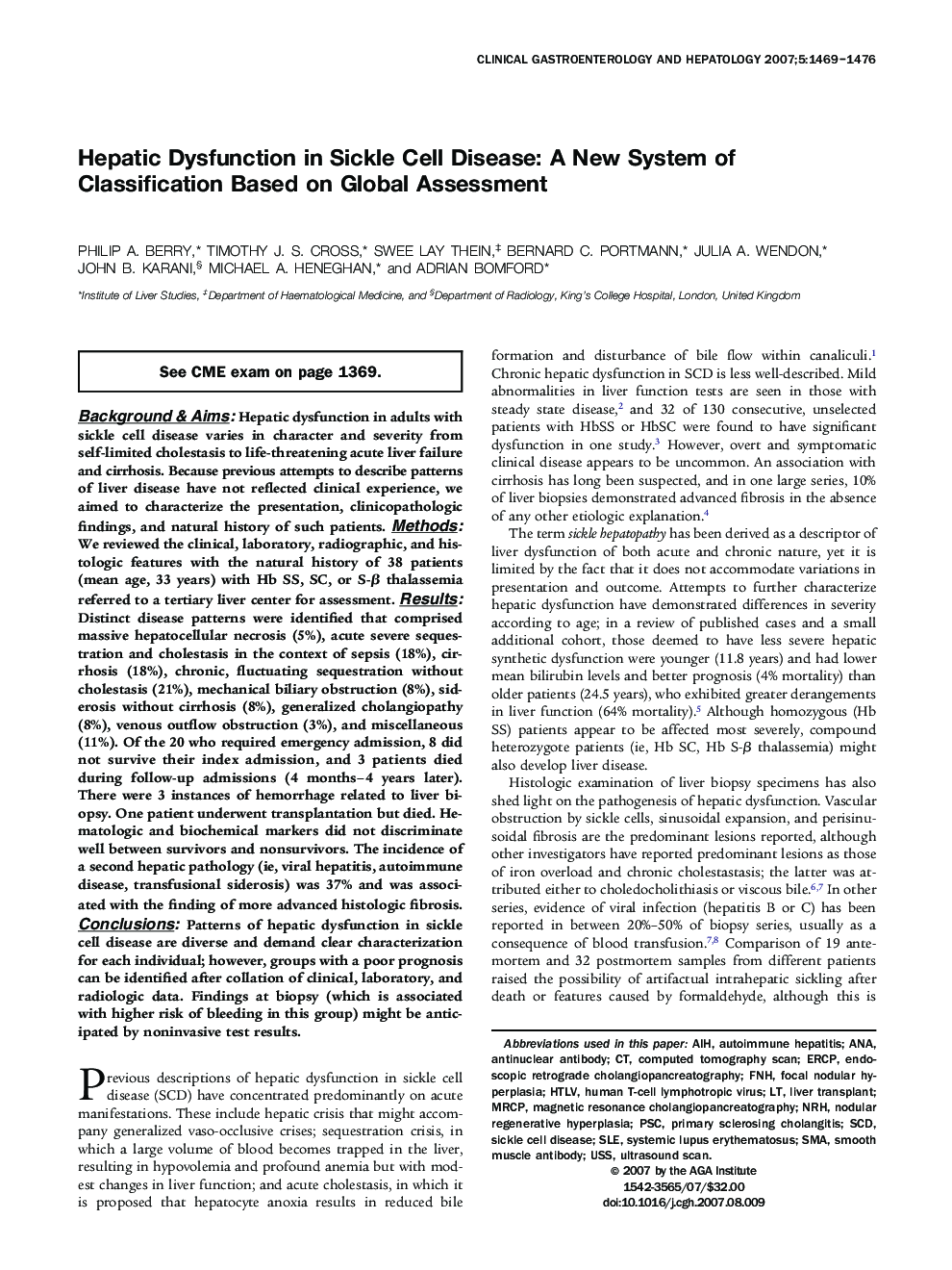| کد مقاله | کد نشریه | سال انتشار | مقاله انگلیسی | نسخه تمام متن |
|---|---|---|---|---|
| 3285767 | 1209240 | 2007 | 8 صفحه PDF | دانلود رایگان |
عنوان انگلیسی مقاله ISI
Hepatic Dysfunction in Sickle Cell Disease: A New System of Classification Based on Global Assessment
دانلود مقاله + سفارش ترجمه
دانلود مقاله ISI انگلیسی
رایگان برای ایرانیان
کلمات کلیدی
USSSCDPSCFNHHuman T-cell lymphotropic virusMRCPAIHHTLVNRHEndoscopic retrograde cholangiopancreatography - cholangiopancreatography رتروگراد endoscopicantinuclear antibody - آنتی بادی ضد سرطانیsmooth muscle antibody - آنتی بادی عضلانی صافUltrasound scan - اسکن با امواج فراصوتcomputed tomography scan - اسکن توموگرافی کامپیوتریANA - اصلیSickle cell disease - بیماری سلول داسی شکلmagnetic resonance cholangiopancreatography - تشدید مغناطیسی cholangiopancreatographySMA - دبیرستانSystemic lupus erythematosus - لوپوس اریتماتوی سیستمیکSLE - لوپوس منتشر یا لوپوس اریتماتوس سیستمیکAutoimmune hepatitis - هپاتیت اتوایمیونnodular regenerative hyperplasia - هیپرپلازی بازسازی گره خوردهFocal nodular hyperplasia - هیپرپلازی گرههای کانونیLiver transplant - پیوند کبدPrimary sclerosing cholangitis - کلانژیت اسکلروئیدی اولیهERCP یا endoscopic retrograde cholangiopancreatography - کلانژیوگرافی آندوسکوپیک عقبگرد یا ایآرسیپی
موضوعات مرتبط
علوم پزشکی و سلامت
پزشکی و دندانپزشکی
بیماریهای گوارشی
پیش نمایش صفحه اول مقاله

چکیده انگلیسی
Background & Aims: Hepatic dysfunction in adults with sickle cell disease varies in character and severity from self-limited cholestasis to life-threatening acute liver failure and cirrhosis. Because previous attempts to describe patterns of liver disease have not reflected clinical experience, we aimed to characterize the presentation, clinicopathologic findings, and natural history of such patients. Methods: We reviewed the clinical, laboratory, radiographic, and histologic features with the natural history of 38 patients (mean age, 33 years) with Hb SS, SC, or S-β thalassemia referred to a tertiary liver center for assessment. Results: Distinct disease patterns were identified that comprised massive hepatocellular necrosis (5%), acute severe sequestration and cholestasis in the context of sepsis (18%), cirrhosis (18%), chronic, fluctuating sequestration without cholestasis (21%), mechanical biliary obstruction (8%), siderosis without cirrhosis (8%), generalized cholangiopathy (8%), venous outflow obstruction (3%), and miscellaneous (11%). Of the 20 who required emergency admission, 8 did not survive their index admission, and 3 patients died during follow-up admissions (4 months-4 years later). There were 3 instances of hemorrhage related to liver biopsy. One patient underwent transplantation but died. Hematologic and biochemical markers did not discriminate well between survivors and nonsurvivors. The incidence of a second hepatic pathology (ie, viral hepatitis, autoimmune disease, transfusional siderosis) was 37% and was associated with the finding of more advanced histologic fibrosis. Conclusions: Patterns of hepatic dysfunction in sickle cell disease are diverse and demand clear characterization for each individual; however, groups with a poor prognosis can be identified after collation of clinical, laboratory, and radiologic data. Findings at biopsy (which is associated with higher risk of bleeding in this group) might be anticipated by noninvasive test results.
ناشر
Database: Elsevier - ScienceDirect (ساینس دایرکت)
Journal: Clinical Gastroenterology and Hepatology - Volume 5, Issue 12, December 2007, Pages 1469-1476
Journal: Clinical Gastroenterology and Hepatology - Volume 5, Issue 12, December 2007, Pages 1469-1476
نویسندگان
Philip A. Berry, Timothy J.S. Cross, Swee Lay Thein, Bernard C. Portmann, Julia A. Wendon, John B. Karani, Michael A. Heneghan, Adrian Bomford,